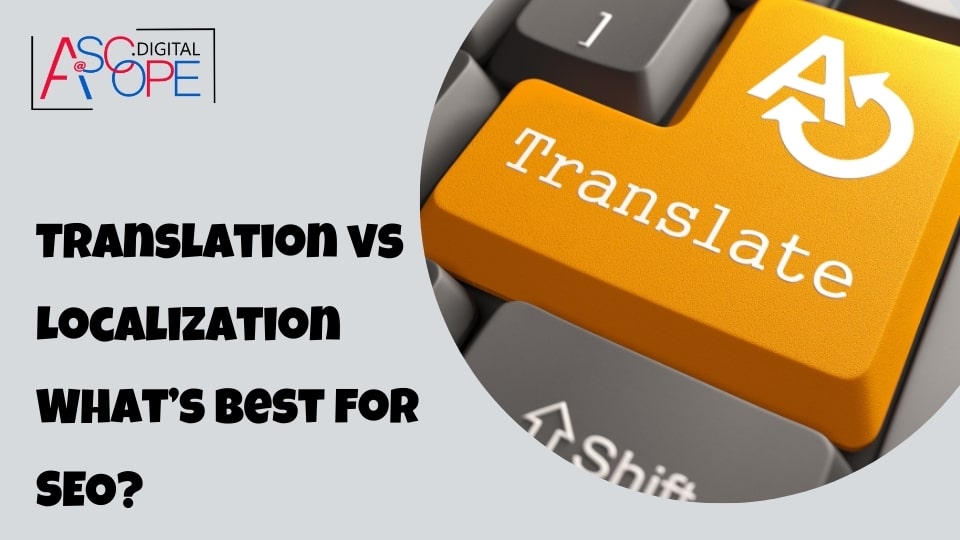Introduction to Translation and Localization
In the interconnected digital age, businesses are no longer confined by geographical boundaries. Expanding into international markets has become a viable strategy for growth, but with this expansion comes the challenge of communicating effectively with a diverse audience. This is where translation and localization come into play. Understanding the difference between these two processes and their implications for SEO is crucial for any business aiming to establish a global presence.
What is Translation?
Translation is the process of converting text from one language to another. It focuses primarily on linguistic accuracy, ensuring that the meaning of the original text is preserved in the translated version. This process is essential for making content accessible to speakers of different languages. For example, an English website translated into Spanish will allow Spanish-speaking users to understand the content without learning English.
Translation is typically a straightforward task that involves converting words and phrases while maintaining the original structure and context. However, it’s not always sufficient for engaging a global audience. This is because translation alone does not account for cultural nuances, regional differences, or local preferences, which can significantly impact user experience and engagement.
What is Localization?
Localization goes beyond mere translation. It involves adapting content to meet the cultural, linguistic, and practical needs of a specific target market. This process ensures that the content feels natural to the local audience, taking into account cultural references, idiomatic expressions, and regional preferences. Localization can include adjustments to images, colors, layout, date formats, and even payment methods to align with local customs and expectations.
For instance, a marketing campaign successful in the United States might not resonate with audiences in Japan without localization. Localization tailors the content to the cultural context of the target audience, making it more relevant and appealing.
Translation vs. Localization: The Key Differences
While translation is an essential part of localization, the two are not synonymous. The key difference lies in the scope and depth of adaptation. Translation focuses solely on converting text, whereas localization encompasses a broader range of elements, including cultural adaptation, user interface adjustments, and even product modifications.
Translation:
- Converts text from one language to another.
- Ensures linguistic accuracy.
- Preserves the original meaning and context.
Localization:
- Adapts content to cultural and regional specifics.
- Ensures cultural relevance and resonance.
- Modifies various elements (text, images, design) to suit local preferences.
The Importance of Localization in SEO
SEO (Search Engine Optimization) is critical for any business looking to increase its online visibility and attract organic traffic. When expanding into international markets, localization becomes an invaluable tool for effective SEO. Here’s why:
- Keyword Relevance: Simply translating keywords from one language to another may not capture the search intent of local users. Localization involves researching and integrating keywords that locals actually use, improving the chances of appearing in search results.
- User Experience: Search engines prioritize websites that offer a good user experience. Localized content is more likely to engage users, leading to longer visit durations and lower bounce rates, both of which positively impact SEO.
- Cultural Sensitivity: Content that resonates culturally with users is more likely to be shared and linked to, generating valuable backlinks and enhancing SEO.
- Compliance and Trust: Localization ensures that content complies with local regulations and norms, building trust with users and search engines alike.
When to Use Translation vs. Localization
Deciding between translation and localization depends on your business goals and the target market. If your primary objective is to make content understandable in another language without a deep cultural adaptation, translation may suffice. However, if you aim to build a strong, engaging presence in a foreign market, localization is essential.
For example, technical documentation or legal texts may only require translation for clarity and accuracy. In contrast, marketing materials, websites, and user interfaces benefit significantly from localization, which enhances relevance and appeal to the local audience.
Understanding the Difference: Translation vs. Localization

In the digital era, expanding into international markets has become a strategic goal for many businesses. As companies strive to reach global audiences, the importance of effective communication across different languages and cultures cannot be overstated. This is where translation and localization come into play. Though often used interchangeably, translation and localization are distinct processes that serve different purposes. Understanding these differences is crucial for businesses aiming to optimize their international presence and enhance their SEO efforts.
Translation: The Basics
Translation is the process of converting text from one language to another. The primary goal is to ensure linguistic accuracy, meaning that the original message is conveyed as accurately as possible in the target language. This process involves finding equivalents for words and phrases in the target language while preserving the original context and meaning.
For instance, translating an English product manual into French involves converting each sentence into its French equivalent, ensuring that the instructions remain clear and understandable. The focus is on linguistic fidelity, making sure that the translated text mirrors the original in terms of meaning and intent.
Localization: Going Beyond Words
Localization, on the other hand, is a more comprehensive process. It involves adapting content not just linguistically, but also culturally and contextually to suit the preferences and expectations of a specific target market. Localization takes into account various factors such as cultural nuances, local customs, idiomatic expressions, and even visual elements like images and colors.
For example, localizing a website for the Japanese market might involve not only translating the text into Japanese but also adjusting the layout, incorporating culturally relevant images, changing date formats, and ensuring that the overall user experience aligns with local expectations. Localization aims to create content that feels native to the target audience, enhancing engagement and resonance.
Key Differences Between Translation and Localization
While translation and localization both aim to make content accessible to foreign audiences, their approaches and outcomes differ significantly. Here are some key differences:
- Scope:
- Translation: Focuses solely on converting text from one language to another while maintaining the original meaning.
- Localization: Encompasses a broader range of adaptations, including linguistic, cultural, and visual elements.
- Cultural Relevance:
- Translation: Ensures linguistic accuracy but may not account for cultural nuances.
- Localization: Adapts content to be culturally relevant and resonant, considering local customs, values, and preferences.
- User Experience:
- Translation: Primarily concerned with clarity and accuracy of the message.
- Localization: Aims to enhance the overall user experience by making the content feel native and familiar.
- SEO Implications:
- Translation: May not effectively capture local search behavior and keywords.
- Localization: Involves researching and integrating locally relevant keywords, improving search engine rankings and visibility.
The Role of Translation in Global Communication
Translation is essential for basic communication across languages. It enables businesses to make their content understandable to non-native speakers, breaking down language barriers. For technical documentation, legal texts, and other content where precise meaning is crucial, translation is often sufficient. It ensures that the core message is conveyed accurately, regardless of the audience’s linguistic background.
The Importance of Localization for Market Penetration
Localization is critical for businesses aiming to establish a strong presence in foreign markets. By tailoring content to the cultural and contextual specifics of the target audience, localization creates a more engaging and relevant experience. This approach is particularly important for marketing materials, websites, and user interfaces, where user engagement and satisfaction are key to success.
Localized content resonates more deeply with the audience, fostering trust and connection. It can also lead to higher conversion rates, as users are more likely to respond positively to content that feels familiar and culturally appropriate. In terms of SEO, localization ensures that content is optimized for local search behavior, incorporating keywords and phrases that local users are likely to use.
Impact of Translation on SEO

In the global digital marketplace, reaching a diverse audience is crucial for the success of any business. One of the fundamental steps in achieving this goal is making your content accessible to speakers of different languages through translation. However, the impact of translation on SEO (Search Engine Optimization) is a nuanced subject that goes beyond merely converting text from one language to another. Understanding how translation influences SEO can help businesses make informed decisions to enhance their international online presence.
Translating Keywords: The Foundation of SEO
Keywords are the cornerstone of any SEO strategy. They are the terms and phrases that users type into search engines to find information, products, or services. Translating keywords from one language to another is not a straightforward task. Direct translations often fail to capture the nuances of local search behavior, leading to a mismatch between the content and what users are actually searching for.
For instance, a keyword that ranks well in English might not have a direct equivalent in another language. Instead, the translated keyword might be a less common term or might not reflect the local dialect. Therefore, it is essential to conduct thorough keyword research in the target language. Tools like Google Keyword Planner and local search engines can provide insights into the most relevant and high-traffic keywords for each market. This ensures that the translated content aligns with the search habits of the local audience, improving visibility and relevance.
Search Engine Algorithms and Multilingual Content
Search engine algorithms, particularly Google’s, are designed to deliver the most relevant results to users. When it comes to multilingual content, search engines consider various factors to determine the relevance and quality of the translated pages. One important factor is the accuracy and quality of the translation. Poorly translated content can be perceived as low-quality, leading to lower rankings and decreased visibility.
Additionally, search engines look for consistency in the use of language across the website. If a website has content in multiple languages, it is crucial to ensure that each language version is complete and coherent. Incomplete or inconsistent translations can confuse search engines and users alike, negatively impacting SEO performance.
Meta Tags and Localized SEO
Meta tags, including title tags and meta descriptions, play a critical role in SEO by providing search engines with information about the content of a page. When translating content, it is important to also translate and optimize these meta tags. This involves incorporating relevant keywords and ensuring that the translated tags are compelling and accurately reflect the content.
For example, if an English meta description includes a popular keyword, the translated meta description should also incorporate the equivalent keyword in the target language. This helps maintain SEO effectiveness across different language versions of the website.
User Experience and Bounce Rates
User experience is a significant factor in SEO. Search engines prioritize websites that offer a positive user experience, which includes aspects such as page load speed, mobile-friendliness, and content relevance. Translated content that accurately conveys the original message and resonates with the target audience can enhance user engagement and reduce bounce rates.
High bounce rates, where users quickly leave a website after viewing only one page, signal to search engines that the content may not be relevant or of high quality. Accurate and culturally appropriate translations can help keep users engaged, leading to longer visit durations and lower bounce rates, both of which positively impact SEO rankings.
Backlinks and International SEO
Backlinks, or inbound links from other websites, are a key component of SEO. They signal to search engines that a website is credible and authoritative. When expanding into international markets, acquiring backlinks from local websites can significantly boost SEO performance.
Translated content that is well-researched, informative, and culturally relevant is more likely to attract backlinks from local websites, blogs, and social media platforms. These local backlinks enhance the website’s authority in the target market and improve its rankings in local search results.
Challenges and Best Practices
While translation is a powerful tool for reaching international audiences, it comes with its own set of challenges. Automated translation tools, though convenient, often produce inaccurate or unnatural translations that can harm SEO efforts. Investing in professional translation services ensures that the content is accurate, culturally relevant, and optimized for local SEO.
Additionally, businesses should implement hreflang tags, which are HTML attributes used to indicate the language and regional targeting of a webpage. Hreflang tags help search engines understand the intended audience for each language version of the website, preventing duplicate content issues and ensuring that users are directed to the most appropriate version of the site.
How Localization Enhances SEO Performance

In today’s digital landscape, businesses are increasingly aiming to reach global audiences. However, reaching international markets involves more than just translating content into different languages. Localization, the process of adapting content to meet the cultural, linguistic, and practical needs of specific locales, plays a crucial role in enhancing SEO performance. This comprehensive approach ensures that content resonates with local audiences, improves user engagement, and ultimately boosts search engine rankings. Here’s an in-depth look at how localization enhances SEO performance.
Keyword Optimization for Local Markets
One of the fundamental aspects of SEO is keyword optimization. Keywords are the phrases and terms that users enter into search engines to find content. While translation can convert keywords from one language to another, it may not always capture the nuances of local search behavior. Localization involves in-depth research to identify and integrate keywords that are most relevant to the local audience.
For instance, a keyword that performs well in English-speaking markets might not have a direct equivalent in another language. Instead, local users might use different phrases or colloquial terms. By conducting thorough keyword research specific to each target market, businesses can ensure that their content aligns with local search habits, increasing the chances of ranking higher in local search results.
Enhancing User Experience
User experience (UX) is a critical factor in SEO. Search engines prioritize websites that offer a seamless and engaging user experience. Localization significantly enhances UX by making content more relevant and accessible to local users. This includes adapting not only the language but also cultural references, imagery, and even website layout to suit local preferences.
For example, localized content may incorporate culturally relevant examples, local idioms, and references that resonate with the target audience. Additionally, adjusting the website layout to accommodate local reading habits (such as right-to-left text direction for Arabic languages) can further enhance user engagement. A positive user experience leads to longer visit durations, lower bounce rates, and higher conversion rates, all of which positively impact SEO rankings.
Boosting Engagement and Social Signals
Engagement metrics, such as time on site, pages per session, and social signals (likes, shares, comments), are important indicators of content quality and relevance. Localized content tends to attract more engagement because it speaks directly to the local audience’s needs and interests. When users find the content relevant and useful, they are more likely to interact with it, share it on social media, and link back to it from other websites.
These social signals and backlinks are crucial for SEO, as they signal to search engines that the content is valuable and authoritative. By localizing content, businesses can foster a deeper connection with local audiences, encouraging them to engage more actively and boost the content’s visibility and authority in search engine results.
Leveraging Local Backlinks
Backlinks from reputable local websites are a powerful factor in SEO. They indicate to search engines that the content is trusted and valued by local sources. Localized content is more likely to attract backlinks from local blogs, news sites, and industry-specific websites, as it is relevant and meaningful to the local audience.
For instance, a localized blog post about industry trends in Japan is more likely to be referenced by Japanese industry blogs and news sites. These local backlinks enhance the website’s authority in the target market, improving its rankings in local search results. By focusing on localization, businesses can build a robust network of local backlinks that strengthens their SEO performance.
Compliance with Local Regulations and Standards
Different countries have varying regulations and standards regarding online content. Localization ensures that content complies with local laws and industry standards, which is essential for building trust with local users and search engines. For example, the European Union’s General Data Protection Regulation (GDPR) requires websites to provide clear information about data privacy in the local language.
By localizing content to meet these regulations, businesses can avoid legal issues and penalties while demonstrating their commitment to user privacy and compliance. This not only enhances the user experience but also boosts the website’s credibility and trustworthiness, which are important factors for SEO.
Implementing Hreflang Tags
Hreflang tags are HTML attributes used to indicate the language and geographical targeting of a webpage. They help search engines understand which version of a page to display to users based on their language preferences and location. Implementing hreflang tags is an essential aspect of localization that prevents duplicate content issues and ensures that users are directed to the most appropriate version of the site.
For instance, a website with different language versions for English (US), English (UK), and Spanish (Spain) can use hreflang tags to guide search engines in displaying the correct version to users in each region. This targeted approach improves the user experience and enhances the website’s visibility in local search results.
Building Local Trust and Brand Loyalty
Localized content builds trust and brand loyalty among local audiences. When users see that a business has taken the time to understand and cater to their specific needs and preferences, they are more likely to trust the brand and become loyal customers. This trust translates into higher engagement, repeat visits, and positive word-of-mouth, all of which contribute to better SEO performance.
In conclusion, localization is a powerful strategy for enhancing SEO performance in international markets. By optimizing keywords for local search behavior, enhancing user experience, boosting engagement, leveraging local backlinks, complying with local regulations, implementing hreflang tags, and building local trust, businesses can significantly improve their visibility and rankings in local search results. Investing in localization is not just about translating content but about creating a tailored, relevant, and engaging experience for each target market, ultimately driving long-term success in the global digital landscape.
Cultural Nuances and SEO: The Role of Localization

In today’s global digital landscape, businesses are increasingly recognizing the importance of reaching diverse audiences. As companies expand their online presence to international markets, understanding and integrating cultural nuances into their digital strategies become crucial. Localization, which goes beyond mere translation, plays a pivotal role in capturing these cultural nuances, ultimately enhancing SEO performance. This comprehensive approach ensures that content resonates with local audiences, improves user engagement, and boosts search engine rankings. Here’s an in-depth look at how cultural nuances and localization influence SEO.
Understanding Cultural Nuances
Cultural nuances refer to the subtle differences in language, behavior, values, and customs that distinguish one culture from another. These nuances influence how people perceive and interact with content. For instance, humor, idioms, symbols, and social norms vary widely across cultures. What might be considered engaging and appropriate in one culture could be misunderstood or even offensive in another.
Ignoring cultural nuances can lead to a disconnect between the brand and its audience, reducing engagement and trust. Therefore, effectively incorporating these nuances through localization is essential for creating content that feels authentic and relatable to the target audience.
The Role of Localization in Capturing Cultural Nuances
Localization involves adapting content to align with the cultural, linguistic, and contextual specifics of a target market. This process includes translating text, but more importantly, it entails modifying various elements to reflect local preferences and customs. Here are some key ways localization captures cultural nuances:
- Language and Tone:
- Localization goes beyond word-for-word translation to capture the intended tone and style of the original content. It considers local expressions, idioms, and colloquialisms, making the content sound natural and engaging to the local audience.
- For example, an informal and friendly tone used in American English might need to be adjusted to a more formal tone for Japanese audiences.
- Visual Elements:
- Images, colors, and graphics used in content can carry different meanings in different cultures. Localization ensures that visual elements are culturally appropriate and appealing.
- For instance, the color white symbolizes purity in Western cultures but is associated with mourning in some Asian cultures. Using culturally sensitive visuals can enhance user engagement and avoid misunderstandings.
- Cultural References:
- Incorporating local cultural references, such as holidays, traditions, and local events, makes the content more relatable and engaging.
- For example, a marketing campaign timed around Thanksgiving in the United States might be adapted to align with the Mid-Autumn Festival in China.
- User Interface and Experience:
- Localization involves adapting the user interface (UI) to meet local expectations. This includes changes in layout, navigation, and even functionality to ensure a seamless user experience.
- For instance, adjusting date formats, measurement units, and currency symbols can significantly improve usability and user satisfaction.
Enhancing SEO Through Localization
Localization not only makes content culturally relevant but also has a direct impact on SEO. Here’s how:
- Keyword Optimization:
- Effective SEO requires using keywords that local users are actually searching for. Localization involves thorough keyword research in the target language to identify and integrate the most relevant and high-traffic keywords.
- For example, a direct translation of the keyword “cheap flights” might not capture the local search intent as effectively as a localized equivalent.
- Localized Meta Tags:
- Meta tags, including title tags and meta descriptions, play a crucial role in SEO. Localizing these tags ensures they are optimized for local search behavior and include relevant keywords.
- This practice helps improve click-through rates (CTR) and visibility in local search results.
- Improved User Engagement:
- Search engines prioritize websites that offer a positive user experience. Localized content that resonates with local audiences leads to higher engagement, longer visit durations, and lower bounce rates, all of which positively impact SEO rankings.
- Engaged users are more likely to share content, link back to it, and generate social signals that enhance SEO.
- Local Backlinks:
- Earning backlinks from reputable local websites is essential for SEO. Localized content is more likely to attract backlinks from local blogs, news sites, and industry-specific platforms, boosting the website’s authority in the target market.
- These local backlinks signal to search engines that the content is valuable and relevant, improving its rankings in local search results.
Case Study: Successful Localization
Consider a global e-commerce company expanding into the Japanese market. Instead of merely translating their website, they invested in comprehensive localization. This included:
- Adapting product descriptions to reflect local preferences and buying behavior.
- Using culturally relevant images and adjusting the website layout to suit Japanese browsing habits.
- Incorporating local payment methods and customer service options.
- Conducting keyword research to identify popular search terms used by Japanese consumers.
As a result, the company saw a significant increase in organic traffic from Japan, higher conversion rates, and improved search engine rankings. This success underscores the importance of localization in capturing cultural nuances and enhancing SEO performance.
When to Choose Translation Over Localization for SEO

In the digital era, expanding your business into international markets involves making strategic decisions about how to present your content to a global audience. Translation and localization are two key strategies used to adapt content for different languages and cultures. While localization is often touted as the superior approach for fully engaging international audiences, there are scenarios where translation may be more appropriate and cost-effective. Understanding when to choose translation over localization for SEO can help businesses optimize their resources while still achieving their international marketing goals.
The Basics of Translation and Localization
Translation is the process of converting text from one language to another. It focuses on maintaining the original meaning and context, ensuring that the target audience can understand the content.
Localization goes beyond translation, adapting the content to fit the cultural, linguistic, and practical nuances of the target market. This process includes modifying images, colors, layouts, idiomatic expressions, and even payment methods to align with local customs and preferences.
Scenarios Where Translation is Sufficient
- Technical Documentation and Legal Texts
Technical documentation and legal texts require high accuracy and precision. These documents often contain standardized terminology that needs to be consistently translated across languages. In these cases, the primary goal is to convey the exact meaning and instructions without the need for cultural adaptation. For example, translating an engineering manual or a legal contract into another language would suffice, as the focus is on clarity and correctness.
- Initial Market Entry with Limited Budget
When a business is testing a new market with limited budget, translation can be a cost-effective way to start. Translating key pages of your website or marketing materials can help gauge the initial interest and demand in the new market. If the translated content generates significant traffic and engagement, further investment in localization can be justified. This approach allows businesses to validate their market entry strategy without committing extensive resources upfront.
- Uniform Global Brand Messaging
Some brands maintain a consistent global image and message that transcends cultural differences. For these brands, the focus is on maintaining the integrity of their brand identity across all markets. In such cases, translation ensures that the core message remains unchanged while making it accessible to different language speakers. For instance, luxury brands often use translation to maintain a uniform image and brand experience worldwide.
- Highly Specialized Content
In industries such as medicine, science, and technology, content often involves highly specialized terminology and concepts that are universally understood by professionals in the field. Translating such content ensures that the precise meaning is conveyed without the risk of misinterpretation. Localization may not be necessary as the target audience is likely to understand the standardized terms and references.
SEO Considerations for Translation
- Keyword Research and Adaptation
While translation focuses on converting content, it’s essential to adapt keywords to the target language. Direct translation of keywords might not capture the local search behavior. Conducting keyword research in the target language ensures that translated content aligns with local search terms, improving visibility in search engine results. For example, translating “affordable flights” to Spanish as “vuelos asequibles” might not be as effective as using the locally popular term “vuelos baratos.”
- Meta Tags and Descriptions
Translating meta tags and descriptions is crucial for maintaining SEO effectiveness. These elements provide search engines with information about the content and help improve click-through rates. Ensure that translated meta tags include relevant keywords and accurately reflect the content to enhance search engine rankings.
- Consistency and Quality
Search engines prioritize high-quality content. Poorly translated content can harm SEO by leading to higher bounce rates and lower user engagement. Investing in professional translation services ensures that the content is accurate, coherent, and of high quality, thereby positively impacting SEO performance.
Balancing Cost and Effectiveness
Choosing translation over localization can significantly reduce costs, making it an attractive option for businesses with budget constraints. However, it’s essential to balance cost-saving with the need for effective communication. In some cases, combining translation with selective localization can provide a middle ground. For instance, translating the main content while localizing key elements such as call-to-action buttons, images, and cultural references can enhance user engagement without the full cost of localization.
Case Study: Effective Use of Translation
Consider a software company expanding its productivity tools to a new market. Initially, they opted for translation to make their product manuals and website accessible in the new language. They conducted keyword research to adapt key SEO elements and monitored user engagement. As the product gained traction, they invested in localization for their marketing campaigns and user interface to improve user experience and engagement further. This phased approach allowed them to optimize costs while effectively entering the new market.
Best Practices for Integrating Translation and Localization in SEO Strategy

In an increasingly globalized world, businesses must optimize their online presence for international audiences to remain competitive. Translation and localization are critical components of an effective SEO strategy when expanding into new markets. While translation involves converting content from one language to another, localization adapts the content to meet the cultural, linguistic, and practical needs of specific target markets. Integrating these processes into your SEO strategy can significantly enhance your reach and engagement with diverse audiences. Here are some best practices for doing so effectively.
1. Conduct Comprehensive Market Research
Before diving into translation and localization, conduct thorough market research to understand the preferences, behaviors, and needs of your target audience. This includes:
- Identifying Local Competitors: Analyze what your competitors are doing in the local market. Understand their SEO strategies, keyword usage, and content types that resonate with the audience.
- Cultural Insights: Learn about cultural norms, values, and preferences that could impact how your content is perceived.
- Language Variants: Identify the specific language variants used in the target market. For example, Spanish used in Spain differs from Spanish used in Mexico.
This research forms the foundation for a tailored SEO strategy that aligns with local expectations and behaviors.
2. Keyword Research and Adaptation
Keywords are the backbone of SEO, and their effective use is crucial when entering new markets. Direct translation of keywords might not capture local search intent accurately. Instead, follow these steps:
- Local Keyword Research: Use tools like Google Keyword Planner, SEMrush, or Ahrefs to find popular search terms in the target language. Look for high-traffic keywords that are relevant to your industry.
- Understand Search Intent: Analyze how local users phrase their searches and what kind of content they expect to find. This helps in crafting content that meets their needs.
- Incorporate Long-Tail Keywords: Long-tail keywords are more specific and often have lower competition. They can help you rank higher and attract more targeted traffic.
By focusing on locally relevant keywords, you improve your chances of appearing in search results and attracting organic traffic.
3. Optimize Meta Tags and Descriptions
Meta tags, including title tags and meta descriptions, play a crucial role in SEO by providing search engines with information about the content of your page. When translating and localizing content:
- Translate and Localize Meta Tags: Ensure that your meta tags are not only translated but also localized to include relevant keywords and appeal to the local audience.
- Maintain Original Intent: The translated meta tags should maintain the intent and appeal of the original, encouraging users to click through to your site.
- Character Limits: Be mindful of character limits for title tags (typically 60 characters) and meta descriptions (typically 160 characters) to ensure they display correctly in search results.
Well-optimized meta tags can improve your click-through rates (CTR) and overall search engine rankings.
4. Localize Content Beyond Text
Effective localization goes beyond just translating text. It involves adapting various elements to align with local preferences and cultural context:
- Visuals and Multimedia: Adapt images, videos, and other multimedia elements to reflect local culture and values. This can include changing images to feature local landmarks, people, or culturally significant symbols.
- Design and Layout: Adjust the website’s design and layout to accommodate language-specific reading habits. For instance, Arabic and Hebrew are read from right to left, necessitating a different layout.
- Units and Measurements: Convert units of measurement, currency, date formats, and other localized elements to ensure they are familiar to the local audience.
These adjustments make your content more relatable and user-friendly, enhancing the overall user experience.
5. Implement Hreflang Tags
Hreflang tags are HTML attributes used to indicate the language and geographical targeting of a webpage. They are essential for:
- Avoiding Duplicate Content Issues: Hreflang tags help search engines understand that different language versions of a page are intended for different audiences, preventing duplicate content penalties.
- Improving User Experience: They ensure that users are directed to the appropriate language version of your site, improving their overall experience.
- Boosting Local SEO: By clearly defining the target audience for each page, hreflang tags can improve your site’s visibility in local search results.
Proper implementation of hreflang tags is critical for managing multilingual sites and optimizing for local search.
6. Quality Assurance and Testing
Ensuring the quality and accuracy of translated and localized content is crucial for maintaining credibility and effectiveness:
- Professional Translation Services: Use professional translation services to ensure linguistic accuracy and cultural relevance.
- Proofreading and Editing: Have native speakers proofread and edit the content to catch any errors or awkward phrasing.
- Testing Across Devices: Test localized content across different devices and browsers to ensure it displays correctly and functions as intended.
High-quality, error-free content builds trust with your audience and improves SEO performance.
7. Monitor and Adjust Your Strategy
SEO is an ongoing process, and it’s essential to continuously monitor and refine your strategy:
- Analytics and Metrics: Use tools like Google Analytics to track the performance of your translated and localized content. Monitor metrics such as organic traffic, bounce rates, and conversion rates.
- User Feedback: Gather feedback from local users to understand their experience and identify areas for improvement.
- Regular Updates: Keep your content up-to-date with local trends, search behavior changes, and algorithm updates to maintain its relevance and effectiveness.
By regularly assessing and adjusting your strategy, you can ensure sustained success in your international SEO efforts.
Conclusion
In conclusion, both translation and localization play vital roles in enhancing your website’s SEO performance. While translation ensures that your content is accurately converted into different languages, localization goes a step further by adapting the content to meet cultural, regional, and linguistic nuances. For businesses aiming to expand their reach globally, a combination of both strategies is often necessary to fully optimize their SEO efforts. Localization is particularly powerful as it aligns your content with local search behaviors and preferences, improving user engagement and reducing bounce rates. This cultural sensitivity not only makes your website more relatable to a diverse audience but also helps search engines recognize its relevance in various regions, thereby boosting your rankings.
However, the choice between translation and localization should be guided by your specific SEO goals and target audience. For some, a straightforward translation might suffice, but for those seeking to deeply penetrate local markets, investing in localization can yield substantial returns. As you evaluate these strategies, it’s crucial to remember that SEO is a multifaceted discipline. Beyond translation and localization, numerous other factors can influence your website’s traffic. For a comprehensive understanding of these elements, read more on the other reasons why your website isn’t getting traffic. By addressing all aspects of SEO, you can create a robust and effective online presence that resonates with a global audience while meeting local expectations.


